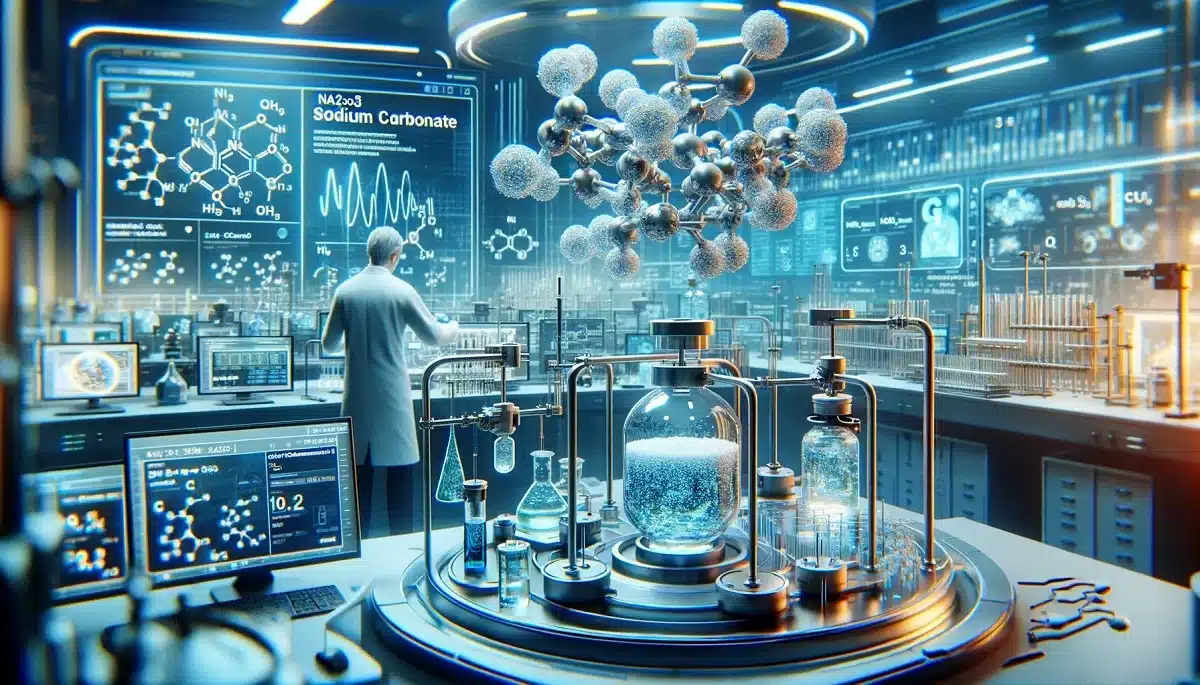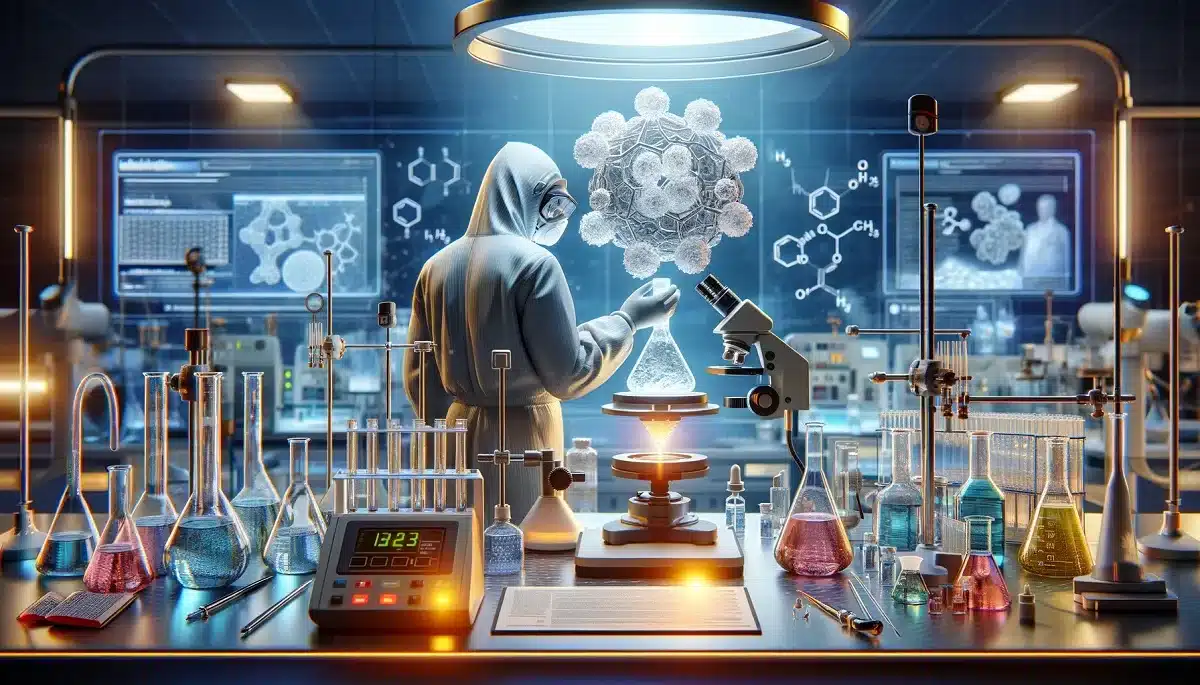Sodium carbonate is one of the oldest known chemical compounds and is also often called soda ash or washing soda. This inorganic compound, whose chemical formula is Na₂CO₃, is used in many household cleaning products, personal care products, and even medical applications.
Sodium carbonate plays a variety of roles in industrial processes and daily life; It is valuable as a water softener, pH regulator, and acidity neutralizing agent. Sodium carbonate, known for its wide range of uses and high solubility and alkaline properties, is an indispensable substance in home and industrial environments.

What is Sodium Carbonate?
Sodium carbonate (Na2CO3) is a chemical compound widely used in industrial and household products. Also commonly known as soda ash or washing soda, this compound has a wide range of uses, from glassmaking to detergents, from the food industry to water purification.
Sodium carbonate can be obtained in nature by processing a mineral called trona or by reacting salt and limestone through chemical processes. This substance, usually found in powder form, forms an alkaline solution when dissolved in water and can neutralize acidic properties. This makes it valuable in many industrial processes and household cleaning.
Basic Properties of Sodium Carbonate
Sodium carbonate is one of the indispensable substances of science and industry with its chemical and physical properties. This section explains why sodium carbonate is so important by providing a detailed explanation of these properties.
Chemical Structure and Formula
Sodium carbonate, whose chemical formula is Na2CO3, consists of sodium (Na), carbon (C) and oxygen (O) atoms. This compound forms a strong alkaline base and when it goes into solution, it dissociates into sodium ions (Na+) and carbonate ions (CO3 2-). This dissociation has a critical role in many applications of sodium carbonate, particularly in its interaction with acids and in adjusting pH balance.
Physical characteristics
Sodium carbonate exists as a solid, white crystalline powder at room temperature. Although it has good solubility in water, its solubility increases further as the temperature of the solution increases. This compound also tends to heat up, and at high temperatures it can release carbon dioxide (CO2) and water (H2O) to form sodium oxide (Na2O). This transformation is especially important in glass production and other thermal processes.
The hygroscopic properties of sodium carbonate, its ability to attract moisture from the air, require special care when storing and using it. Moisture can cause sodium carbonate to increase in mass and volume, so it should be stored in dry, airtight containers.
This detailed review sheds light on the basic chemical and physical properties of sodium carbonate, providing readers with the opportunity to understand the wide range of applications of this compound and why it is so preferred.
Production of Sodium Carbonate
The production of sodium carbonate is an important industrial process for the manufacture of various products. This chapter takes an in-depth introduction to the two main production methods, natural extraction and synthetic processes.
Obtaining from Natural Resources
Naturally occurring sodium carbonate is mined from large deposits, especially in the form of the trona mineral. The United States state of Wyoming is home to some of the largest trona mines in the world. The extraction process includes the extraction of the mineral through mining, followed by crushing and purification. This method is environmentally friendly as it is based on natural resources and minimizes the need for chemical treatment.
Synthetic Production Methods
In areas where trona is not readily available, sodium carbonate is produced synthetically through the Solvay process. This method involves reacting sodium chloride (salt) with calcium carbonate (limestone) in the presence of ammonia and carbon dioxide. More energy-intensive and complex than extraction from natural sources, the Solvay process allows sodium carbonate to be produced in areas remote from natural deposits.
Industrial Uses of Sodium Carbonate
The versatility of sodium carbonate is evident through a variety of industrial uses, making it indispensable in a variety of sectors.
Its Role in Glass Production
In the glass manufacturing industry, sodium carbonate functions as a fluid that lowers the melting point of silica. This feature allows silica to melt more easily at high temperatures and reduces energy consumption. Glass produced with the addition of sodium carbonate becomes clearer and more processable, which are qualities sought especially in products such as window glass and bottles.
Use in Detergent and Cleaning Products
Sodium carbonate is widely used in detergents and other cleaning products for its ability to soften hard water and dissolve dirt. It has an important place in the formulation of these substances and strengthens effects such as stain removal.
Applications in the Food Industry
In the food industry, sodium carbonate is used as an acidity regulator and baking soda. It provides a baking effect in pastries and some desserts, making the products have a light and porous structure. This use makes sodium carbonate an important ingredient in the food industry.
Sodium Carbonate and the Environment
While sodium carbonate is used in a wide range from industry to home use, its environmental effects and sustainable ways of use are also important.
Environmental Impacts and Sustainability
The environmental impacts of sodium carbonate vary from production methods to post-use. While deriving it from natural sources generally has less environmental impact, synthetic production processes can be energy-intensive and leave a carbon footprint. Release of sodium carbonate into water bodies can have adverse effects on aquatic life, especially at high concentrations. Therefore, sustainable production methods and waste management strategies are critical to reducing environmental impacts.
Waste Management and Recycling Efforts
Proper management of waste containing sodium carbonate is key to minimizing environmental damage. Recycling or safely disposing of these wastes helps protect water resources and soil. Industrial users should be encouraged to develop innovative methods to reduce and recycle sodium carbonate waste.
Laboratory Uses of Sodium Carbonate
Sodium carbonate also plays several important roles in laboratory environments.
Importance in Research and Analysis
In scientific research, sodium carbonate has a critical role in adjusting pH, preparing solutions, and regulating chemical reactions. Its use as a buffer solution in analytical chemistry, especially in titration processes, emphasizes its indispensability in laboratories.
Use in Education
In the field of education, sodium carbonate provides chemistry students with practical experience in basic chemical reactions and properties of matter. Its use in laboratory experiments enables students to understand chemical processes and develop scientific thinking skills. This substance is an integral part of educational chemistry laboratories as a safe and effective learning tool.
Sodium Carbonate in Daily Life
Sodium carbonate is used in many areas in daily life, especially in household cleaning and personal care products.
Uses in House Cleaning
In household cleaning, sodium carbonate is preferred as a natural and effective cleaner. As a powerful stain remover and neutralizer of bad odors, it offers a wide range of uses, from kitchen surfaces to bathrooms, from carpets to laundry. Particularly effective on oily surfaces and stubborn stains, sodium carbonate is a strong competitor to chemical cleaners as an environmentally friendly alternative.
Its Role in Personal Care Products
In personal care products, sodium carbonate is an effective ingredient in products ranging from deodorants to toothpaste. As a natural deodorant, it can neutralize body odor, and in toothpastes, it has the feature of whitening teeth and supporting oral health. It is also used as a gentle exfoliating agent in skin care products, helping the skin look healthier by removing dead skin cells.
Relationship between Sodium Carbonate and Health
Sodium carbonate also has a variety of uses in the healthcare industry, but it is important to be aware of the potential health risks as well.
Medical Uses and Importance
In the medical field, sodium carbonate is used especially as an acidity regulator and antacid. It has an important role in regulating the acid-base balance in the body in emergency departments and intensive care units. It is also used in the formulation of some drugs, ensuring more effective dissolution and absorption of the drug in the body.
Potential Health Risks
Although it has many benefits, excessive use of sodium carbonate may pose some health risks. When taken in large amounts, especially when swallowed, it may cause irritation of the stomach and intestines. Additionally, direct contact with skin and eyes may cause irritation, especially with prolonged or intense contact. Therefore, it is important to pay attention to recommended amounts and safety precautions when using sodium carbonate.
The Future of Sodium Carbonate
Sodium carbonate continues to evolve with ever-improving technology and changing industry needs.
Innovative Uses and Research
Innovative uses and ongoing research are expanding sodium carbonate’s potential and creating new applications. For example, environmentally friendly technologies and sustainable energy solutions are redefining the role of sodium carbonate; This compound offers potential for more effective ways to reduce air pollution and use it in water purification systems. Additionally, advances in nanotechnology and advanced materials science may reveal new and exciting uses for sodium carbonate.
Market Dynamics and Trends
Market dynamics and trends shape the future demand and applications of sodium carbonate. Global economic conditions, environmental regulations and consumer preferences may affect this compound’s position in the market. In particular, increasing interest in green chemistry and sustainable production methods may reshape the methods in the production and use of sodium carbonate.
Frequently Asked Questions About Sodium Carbonate
- Is sodium carbonate natural?
- Sodium carbonate can be obtained from both natural sources and produced synthetically. While it is obtained naturally by processing the trona mineral, it is produced synthetically by methods such as the Solvay process.
- What are the health effects of sodium carbonate?
- Sodium carbonate is generally safe when used in low amounts and appropriately. However, it may cause irritation when taken in high doses or when in contact with the skin for a long time.
- How can sodium carbonate be used at home?
- It can be used as a home cleaning product and in personal care products such as stain remover, deodorant or toothpaste. It also functions as a baking soda in baking.
- What is the difference between sodium carbonate and sodium bicarbonate?
- While sodium carbonate (Na2CO3) is a stronger alkali, sodium bicarbonate (NaHCO3), i.e. baking soda, is a milder alkali and is often used in baking processes.
- Is sodium carbonate harmful to the environment?
- When used correctly and waste management is done properly, sodium carbonate causes minimal harm to the environment. However, mixing into water resources in large quantities may be harmful to aquatic creatures.
